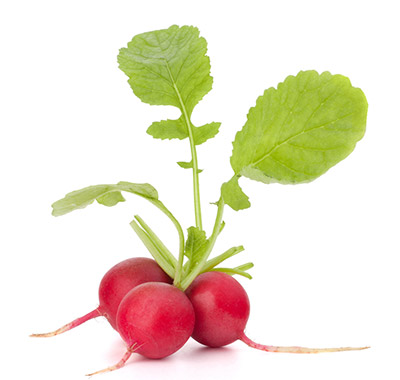 Radishes may be a vegetable you aren’t very familiar with. Maybe they were just that vegetable you pushed to the side when you ate a salad or saw on your plate as a garnish at a restaurant. But radishes can be a vegetable that can stand on their own. In fact, for gastric sleeve, gastric bypass, and gastric band patients they can be a good choice.
Radishes may be a vegetable you aren’t very familiar with. Maybe they were just that vegetable you pushed to the side when you ate a salad or saw on your plate as a garnish at a restaurant. But radishes can be a vegetable that can stand on their own. In fact, for gastric sleeve, gastric bypass, and gastric band patients they can be a good choice.
Radishes are low in calories and carbohydrates, which makes them a good fit for a weight loss diet including a bariatric diet. A ½ cup of fresh, sliced radishes has only 12 calories and 2 g of carbohydrates. While they are not particularly high in any vitamins or minerals, they do offer about 14% of your vitamin C in a ½ cup portion. They also contain small amounts of potassium, folate, riboflavin, niacin, B 6, vitamin K, calcium, zinc, copper, phosphorus, magnesium, and manganese. The ½ cup portion also provides 1 gram of fiber, which is beneficial for keeping your bowels regular. In addition, radishes have antifungal compounds and anthocyanins.
As a root vegetable in the Brassica family, radishes are related to broccoli, mustard greens, kale, cauliflower, cabbage, and turnips. But radishes look very different from their green, leafy relatives. They do have green leaves that grow on top of the soil, but underneath grow a round or ovular shaped red bulb with a root. Radishes may pack a surpise: when you cut into them you will see that the flesh inside is a crisp white. The greens can be cooked up and eaten or added to a salad.
Radishes have an interesting flavor. Some say they are spicy or have a peppery flavor. Smaller radishes tend to have the best flavor. Bigger radishes can get overly pungent. Radishes work well sliced thinly and eaten like a chip with a crunchy texture. This works well with hummus or a Greek yogurt-based dip for additional protein. They can also be shredded and added to salads, both green salads and protein-based salads like chicken and tuna salad. Sliced or shredded radishes can also be used to top a taco platter for an added crunch.
Gastric sleeve, gastric bypass, and lap band patients should only try radishes when they have successfully advanced to the appropriate stage in Dr. Shillingford’s Post Op Diet. As they are a crunchy vegetable you may not be able to soften them enough to eat in Stage 5, but once raw vegetables are allowed in Stage 6 and beyond radishes can be a good fit. As always, take small bites and chew well. Listen to your body to see if you are tolerating the food. Stop eating if you are not. If you have tried radishes before and did not like them, try them again as food preferences have been known to change after weight loss surgery.
Dr. Shillingford, MD, PA is a board-certified surgeon specializing in advanced laparoscopic and bariatric surgery. His gastric sleeve, gastric bypass, and lap band patients can about different foods and how they can fit into a bariatric diet by reading Dr. Shillingford’s other blogs about cabbage, kohlrabi, microgreens, scallops, ginger, walnuts, and baobab. For more interesting information about foods, “like” Dr. Shillingford’s Facebook page. For more information about gastric sleeve surgery, gastric bypass surgery, or lap band surgery with Dr. Shillingford, please call his Boca Raton office at (561) 483-8840.



